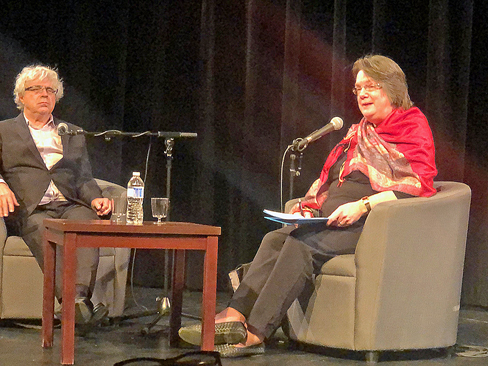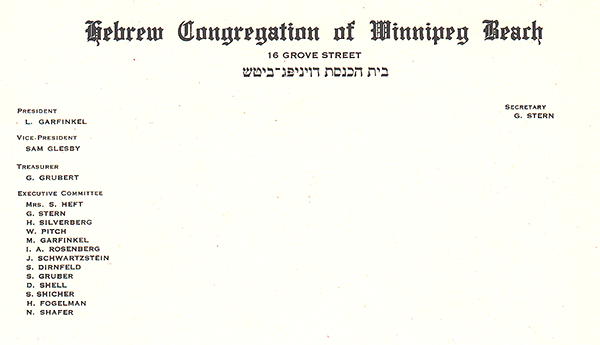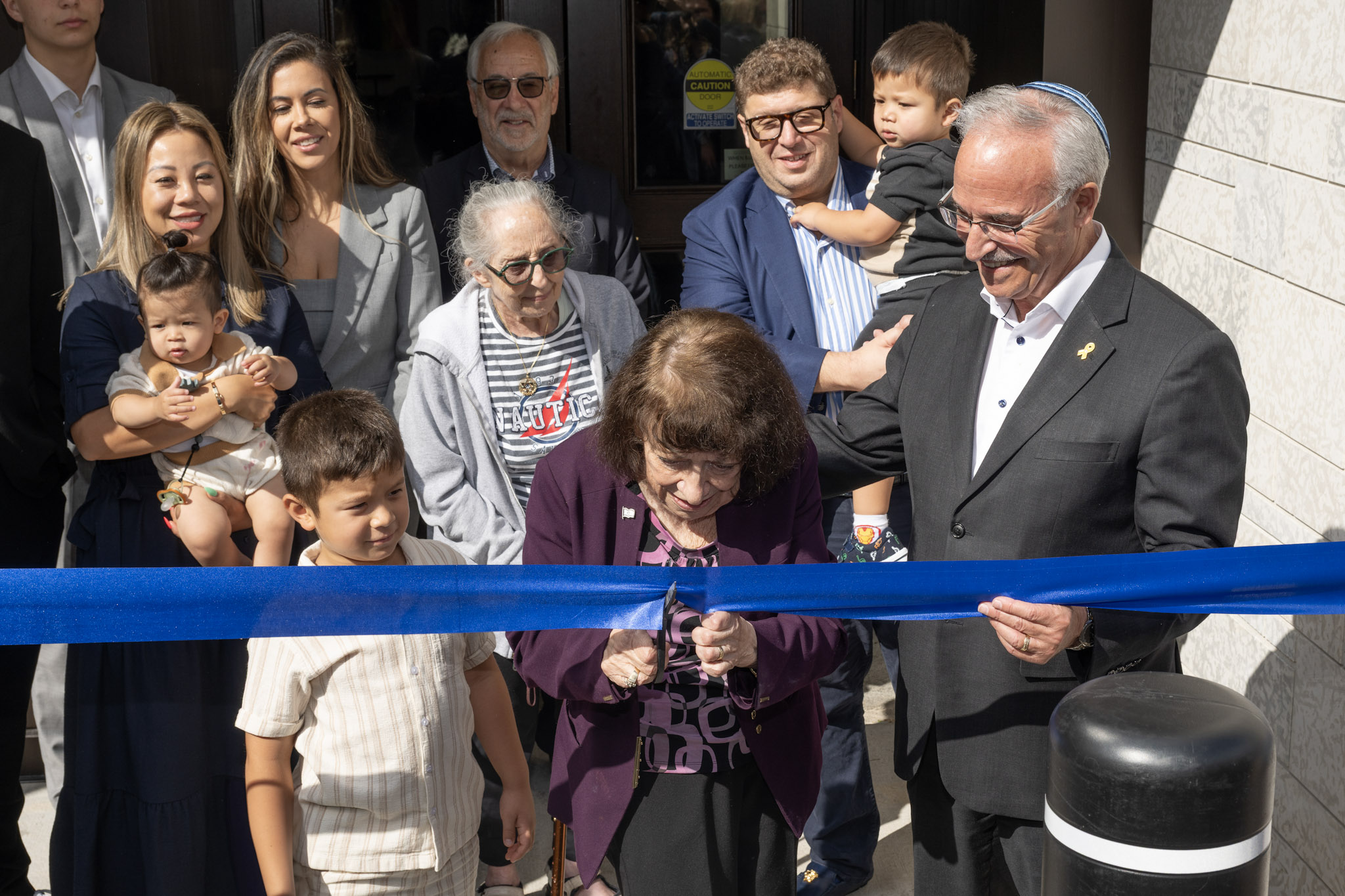Local News
Professor Bryan Schwartz weighs in on issue of campus antisemitism

By BERNIE BELLAN The emergence of antisemitism on university campuses on Canada since the Hamas massacre of October 7 has shocked and saddened much of the Jewish community.
Whether it’s ongoing rallies and demonstrations against Israel, Jewish students being bullied and threatened, or – perhaps what has come to be one of the most insidious forms of Jew hatred – the vehement denunciations of Israel by academics who refuse to countenance opposing views, university campuses in both the United States and Canada have become hostile environments for Jews, both students and teachers.
On Thursday, November 30, Professor Bryan Schwartz of the University of Manitoba Law School, engaged in a dialogue with Dr. Ruth Ashrafi, Regional Director Manitoba, B’nai Brith Canada about the subject of campus antisemitism. The setting was the Berney Theatre at an event organized by Winnipeg Friends of Israel and B’nai Brith Canada, which drew a very large crowd, made up of a good mix of younger and older members of the community, along with many individuals from outside the community as well.
Prof. Schwartz is certainly good for some choice quotes, but much of his analysis of what is happening to Jews as a group certainly leaned toward being heavily pessimistic and, when it came to offering advice how to combat campus antisemitism well, frankly, he didn’t have much to suggest in the way of concrete advice beyond extolling the merits of a free exchange of ideas.
In fact, Prof. Schwartz repeated the expression “Jews don’t count” several times during the evening, explaining what he meant by saying that is “there aren’t a lot of Jews to count.” If it’s simply a matter of Jews being outnumbered, however, then there isn’t much that can be said to counter the torrent of antisemitism that’s been unleashed. But, as I note in my Short takes column in this edition, a professor at Columbia University by the name of Shai Davidai has achieved a high degree of recognition as the result of a Youtube video that was posted of him denouncing the administration of Columbia University for enabling antisemitism on that campus.
Frankly, Prof. Haskell Greenfield, who’s head of the Judaic Studies program at the University of Manitoba, has also been urging a much stronger stand be taken against university administrators who wring their hands and resist denouncing antisemitism on their campuses – and that includes the president of the University of Manitoba, even more so the president of the University of Winnipeg – which has a shocking number of so-called “expert” academics for whom an open exchange of ideas is anathema.
With reference to what it’s like being a university professor who is willing to stand up for Israel, Prof. Schwartz admitted,: “It’s pretty lonely where I am.” The much easier route to follow, Prof. Schwartz suggested, is for academics who want to further their career ambitions to join in on the piling on of Israel.
“What’s easy is going along to get along,” he said. “It’s a safe environment to follow the official doctrine.”
In introducing Prof. Schwartz, Dr. Ashrafi noted that he has just authored a recently-published book titled, “Reenlightening Canada” which, although it was written prior to October 7, sheds a great deal of light on the dire situation in which so many Jews, especially students on university campuses, now find themselves.
In his opening remarks, however, Prof. Schwartz set the tone for what proved to be a deeply depressing outlook on what the future holds, not only for Jewish students on campuses, but for Jews everywhere
“The arc of history is not trending toward Jewish survival,” he suggested. Later in the evening he added this: “I can’t think of another civilization that’s facing extinction as we are.”
“A university is supposed to be a place where you excel based on your excellence,” Prof. Schwartz said. “That was the only criterion in which Jews have been able to survive.”
Now, however, the ideology at universities has become dominated by what he described as “DEI”: Diversity, Equality, and Inclusion.
What’s been happening, Prof. Schwartz explained, is that campuses have been applying litmus tests for would-be academics based on how well they score on the criteria of DEI. Later in the evening, he repeated his condemnation of the sweeping trend toward DEI on university campuses, noting that there are entire bureaucracies at universities “largely hostile to Israel,” populated by DEI officers. He opined, “The Woke industrial complex is a big business. DEI is a big business.”
Dr. Ashrafi spoke of a book by someone by the name of David Batthil, who is a British comedian. A couple of years ago Batthil wrote something called “Jews Don’t Count: How Identity Politics Failed One Particular Identity.”
As Batthil points out in his book, and as Dr. Ashrafi explained to the audience, “Jews are white (strike one), privileged (strike two), and part of the structure of white hegemony” (strike”(strike three) – to use the stereotypical description of Jews now so popular with “Woke” academia.
Since October 7 we’ve now seen how it’s become fashionable for so many members of academe to engage in those tropes. It’s as if the events of the past two months have unleashed pent-up feelings of hatred toward Jews that were bubbling under the surface, but which many might have been embarrassed to admit prior.
Returning to Prof. Schwartz’s dire warning that Jews are on the wane, he recited some figures to back up that contention.
“There is a worldwide shortage of Jews,” he observed. “Jews make up 2 percent of the world’s population.’ (I did some fact checking: There are 14 million Jews in the world. There are 2.38 billion Christians and 1.8 billion Muslims.) “The myth is we’re so powerful…What difference does it make to the people in power?… It’s very career enhancing to criticize Israel.”
Dr. Ashrafi asked Prof. Schwartz about Jews finding themselves in quandaries wondering now about the financial support so many have given to universities – and what should they do going forward ?
Prof. Schwartz used an interesting analogy – that seemed to perplex most of the audience, when he responded that many Jews are now having a “Colonel Nicholson moment.”
He explained that Colonel Nicholson was a character in the movie, “Bridge Over the River Kwai” (played by Alec Guinness) who, upon realizing that he had been aiding and abetting the Japanese enemy by helping to construct a bridge that was intended solely to prolong the Japanese war effort, asked himself: “What have I done?”
That is what many Jewish donors to academic institutions must now be asking themselves, Prof. Schwartz observed. (Again, I refer to Prof. Shai Davidai of Columbia University, who offers a clear prescription for how Jewish donors to academic institutions should respond to what is happening on campuses everywhere. He suggests that you not call or write to your alma mater or favoured institution saying you’re not going to be making a donation; rather, he says, “Wait until they call you, then say no.” However, I’m writing this in the same issue where Myron Love profiles the University of Manitoba’s Jewish Vice-President, Donor Relations. There is some irony there.)
Prof. Schwartz offered an imaginary description of a Jewish student applying for advancement at a typical university these days. When asked about their background and the student says, “I went to Jewish school, to Jewish summer camp, and to Israel, and my parents are well-to-do – it’s not going to do a lot for you when it comes to passing the DEI litmus test.”
Instead of donating to universities, Prof. Schwartz suggested, “Jewish donors should expend some of their energy and goodwill making sure the next generation of Jews will survive,” by insuring that anyone who wants to send their kids to a Jewish school will be able to do so regardless of their income.
He also recommended looking to the concept of “free universities,” where no tuition would be charged. Instead, they would be supported by donations, but where a free exchange of ideas would be guaranteed, not hampered by notions of political correctness
Prof. Schwartz turned to the subject of religion, suggesting that “the Jewish religion is a lot more tolerant than the ‘Woke’ religion.”
“There were many flawed characters in the Bible,” he observed, pointing to King David as an example.
“The Talmud is a record of debates,” he added, whereas “Woke religion is a substitute for many forms of religiosity.”
As for the Jews who have been joining the pro-Hamas crowd, Prof. Schwartz offered this pithy comment: “What good is an anti-Israel demonstration without a ‘show Jew’?”
At that point, Dr. Ashrafi said she wanted to entertain questions from the audience. I happened to be sitting right near where Adriana Glickmann of B’nai Brith was holding the mobile mic, so I motioned for Adriana to hand me the mic. (I’m usually too shy to ask questions – well, maybe not.)
I asked Prof. Schwartz about a story that had just appeared in that day’s Free Press – about a University of Manitoba nursing student who had been suspended for one year from the program, allegedly over anti-Semitic posts on her Instagram account.
I said that I was shocked that university administrators actually took steps to sanction a student over anti-Semitic posts and I wondered whether perhaps the U of M Faculty of Nursing administration had shown other administrators at universities here how to respond to anti-Semitic behaviour?
Prof. Schwartz responded that he wasn’t able to comment about that particular case because he didn’t have all the “facts,” saying “I have to learn more…Merely having a non-conforming view is not sufficient” grounds for punishment, he suggested.
He added though, that “if we had an atmosphere of free discussion, then the Jewish cause would do quite well.”
Someone asked Prof. Schwartz if he could distinguish between free speech and hate speech?
He responded: “In practice, free speech means you have the freedom to denounce Israel.”
He did go on to offer a scholarly review of how the Supreme Court has approached the subject of “hate speech,” suggesting that the court takes a very narrow view of what might constitute hate speech, saying that it has to constitute “hate toward an identifiable group.”
Another questioner wondered “why aren’t there reasonable limits being placed on spewing antisemitism?”
Prof. Schwartz suggested that “being a university president doesn’t prevent you from speaking up.” He added though, that “Jewish faculty are afraid to speak up. You want to be an academic and not get pilloried. What’s easy is going along to get along. It’s a safe environment to follow the official doctrine.” (That certainly doesn’t apply to Prof. Haskell Greenfield, who has been actively pressing the administration at the U of M to do much more to protect Jewish students and faculty on campus by, for instance, clamping down on pro-Palestinian demonstrations that have been organized by groups that have no standing at that campus.)
Prof. Schwartz added: “The President of the U of W can say something about events where there’s no balance,” such as that marathon hatefest toward “genocidal, colonial, imperalist Israel” conducted by seven U of W professors on Friday, November 24.
On the other hand, Prof. Schwartz observed, anyone who dares to take a stand in favour of a balanced presentation has to be thinking: “What’s in it for me?”
Similarly, “if you want to get your grant money” you many come to the realization that “Jews aren’t actually powerful” and viciously attacking Israel isn’t going to hurt you monetarily.
Dr. Ashrafi observed that she’s seen “students kicked off Zoom conferences because they voiced support for Israel.” Nevertheless, she added: “We are resilient. We do not give up. We hold people to account. That’s what we do at B’nai Brith.”
Prof. Schwartz concluded with this assessment: “We’re not going to win the censorship debate where we’re arguing about censoring this, censoring that. The only hope is that in an atmosphere of free discussion the truth will prevail.”
Local News
Thank you to the community from the Chesed Shel Emes

We’re delighted to share a major milestone in our Capital Campaign, “Building on our Tradition.” Launched in November 2018, this campaign aimed to replace our outdated facility with a modern space tailored to our unique needs. Our new building is designed with ritual at its core, featuring ample preparation space, Shomer space, and storage, creating a warm and welcoming environment for our community during times of need.
We’re grateful to the nearly 1,000 generous donors who contributed over $4 million towards our new facility. A $750,000 mortgage will be retired in November 2025, completing this monumental project in just seven years.
We’re also thrilled to announce that our Chesed Shel Emes Endowment Fund has grown tenfold, from $15,000 to $150,000, thanks to you, the Jewish Foundation of Manitoba’s FundMatch program, and Million Dollar Match initiative in 2024. Our fund helps ensure that everyone can have a dignified Jewish funeral regardless of financial need.
As we look to the future, our goal remains to ensure the Chevra Kadisha continues to serve our community for generations to come. Our focus now shifts to replenishing our savings account and growing our JFM Endowment fund.
We’re deeply grateful for your support over the past several years.
It’s our privilege to serve our community with care and compassion.
With sincere appreciation,
Campaign cabinet: Hillel Kravetsky, Gerry Pritchard, Stuart Pudavick,
Jack Solomon, and Rena Boroditsky
Murray S. Greenfield, President
Local News
Winnipeg Beach Synagogue about to celebrate 75th anniversary

By BERNIE BELLAN (July 13) In 1950 a group of cottage owners at Winnipeg Beach took it upon themselves to relocate a one-room schoolhouse that was in the Beausejour area to Winnipeg Beach where it became the beach synagogue at the corner of Hazel and Grove.
There it stayed until 1998 when it was moved to its current location at Camp Massad.
On August 2nd members of the synagogue will be holding a 75th anniversary celebration.

As part of the celebration anyone who is a descendant or relative of any of the original members of the first executive committee (as seen in the photo here) is invited to attend the synagogue that morning.
If you are a relative please contact Abe Borzykowski at wpgbeachshule@shaw.ca or aborzykowski@shaw.ca to let Abe know you might be attending or for more information about the 75th anniversary celebration.
We will soon be publishing a story about the history of the beach synagogue, which is something I’ve been writing about for over 25 years.
Local News
Vickar Family cuts ribbon on new Tova Vickar and Family Childcare Centre

By MYRON LOVE In the words of Larry Vickar, the Shaarey Zedek’s successful Dor V’ Dor Campaign “is not only a renewal of the synagogue but truly a renewal movement of Jewish life in our community.”An integral part of that renewal movement was the creation of a daycare centre within the expanded synagogue. On Monday, June 23, Larry and Tova Vickar cut the ribbon, thereby officially opening the Tova Vickar and Family Childcare Centre in the presence of 100 of their family members, friends and other supporters of the project.
The short program preceding the morning ribbon-cutting began with a continental breakfast followed by a welcome by both Fanny Levy, Shaarey Zedek’s Board President, and Executive Director Dr. Rena Secter Elbaze. In Elbaze’s remarks, she noted that Larry and Tova wanted their family (including son Stephen and family, who flew in from Florida) and friends at the event to celebrate the opening of the Tova Vickar and Family Childcare Centre, “not because of the accolades, but because, as Larry put it, he hopes that their investment in the congregation will inspire others to do the same.”
“When Larry and I spoke about what this gift meant to him and the message he wanted people to take away,” she continued, “I couldn’t help but connect it to the teachings of Reb Zalman Schachter-Shalomi whose book – Age-ing to Sage-ing – changes the whole way we look at the concept of ageing and basing it on our ancestral teachings.”
She explained that his concept of “Sage-ing” is based on three key ideas – Discover your meaning and purpose; accept our mortality and think about the legacy you want to leave.
“Larry spoke about these exact concepts when we met,” she said.
Elbaze also noted the presence of Shaarey Zedek’s newly-arrived senior Rabbi Carnie Rose, former Rabbi Alan Green, and area MLAs Mike Moroz and Carla Compton.
Larry Vickar expressed his great appreciation for all those in attendance. “Tova and I are deeply moved to stand here with you today for this important milestone in our community”, he said. “We are grateful to be surrounded by all of you, the people we care about, our family and friends… you who have touched our lives and played some part in our journey.”
